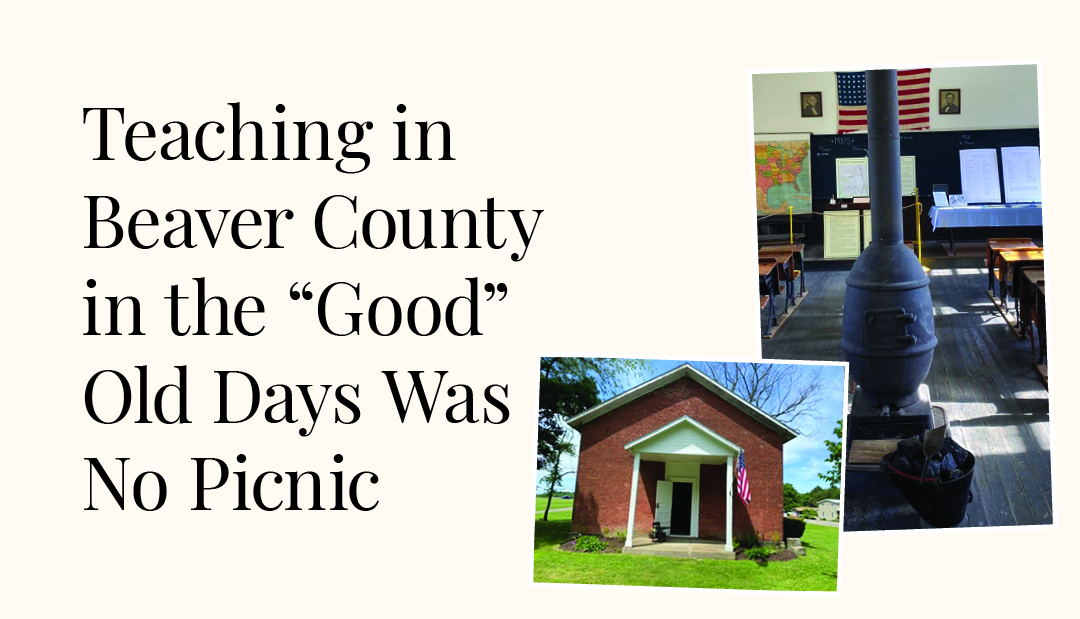This article was written by Robert and Kathleen Millward and reprinted in part from Beaver County Historical Research and Landmarks Foundation’s the Milestones newsletter, Vol 34 No.2.
In 1958, the Pennsylvania State Superintendent recorded in this annual report that schools in Beaver County were spending only 48 cents a year to educate each of its students. Of course, an academic year at that time was only 4 months, November through March, but 48 cents per pupil was still hardly enough to give Beaver County teachers a decent salary. In 1860 the 3 male teachers in Big Beaver were earning only $15.00 a month and the female teachers were paid even less, $9.75 per month. The concept of equal pay for equal work was non-existent in 19th century Western Pennsylvania, as it was throughout the country. If you were a male teacher looking for a job in Beaver County in 1858, you might have tried getting hired in the village of Fallston where male teachers earned the highest salaries in the county, $35.00 a year (for a 6month year).
Average monthly salaries for Pennsylvania teachers:
1854 Male: $29.31, Female: $12.81
1864 Male: $25.42, Female: 20.16
1874 Male: $41.88, Female $33.33
1883 Male: $36.23, Female $28.30
Beaver County had 141 schools in 1860, and the average monthly salary was $25.44 for male instructors and $15.25 for female instructors IF you got paid at the end of the month. If the crops failed, farmers couldn’t pay their school taxes, so there was no money to pay the teachers. By 1863, when Lincoln was president and Beaver County was sending hundreds of men off to fight in the Civil War, Beaver County had 21 more schools (162) , but teacher salaries remained pretty much the same. The average pay for male teachers was $25.00 per month and $18.25 for female teachers. Male teachers in Freedom however, were making a whopping $40.00 during the Civil War years while the 2 female teachers made only $17.00 per month.
Along with rock bottom wages, most of these teachers had to endure harsh working conditions. In the “good” old days of American education, there were no janitors, so the teacher was entirely responsible for maintenance of the school. This meant keeping the school clean and getting up at the crack of dawn every day in order to arrive at the schoolhouse early enough to fire up the coal stove before the children arrived. For those teachers who were not boarding with a local farmer, it was often a long, rigorous walk to work on bitterly cold Pennsylvania winter mornings, and some incurred frostbite by the time they arrived at their destination.
In addition to assuming a janitor’s duties, a teacher in Beaver County’s one room schoolhouses also had to act as the principal as well as the school nurse, counselor, social worker, and record keeper, all on a virtual poverty level salary. Teaching was clearly not a dream job in the good old days. It was more often than not a demoralizing occupation with low pay, low prestige, and no job security whatsoever. Consequently, the turnover rate was quite high, with some teachers even leaving their jobs before the end of the school year.
Many of Beaver County’s teachers would have had to “board round”. Schoolhouses were usually located in isolated areas, and since most teachers couldn’t afford to buy a horse and walking to and from work would take far too much time, teachers often had to move in with a different family each week throughout the school term. At the end of the week, they’d have to pack up their meager belongings and head to a new farm and adjust to a new family.
Western Pennsylvania teachers often wrote about their bleak living conditions in these strangers’ farmhouses: being relegated to cold attic rooms with no heat where snow and rain blew right into the room through the cracks in the walls, living with little or no privacy, being forced to sleep in the same room with 3 or 4 of their students, having no social life at all during the week, or often on weekends as well. This must have been particularly hard o the younger teachers. We often forget that many of the one room school teachers were just kids themselves.
If your parents were born in Beaver County after 1900, there were among the first group of students who could attend the newly built Beaver County high schools.
Today, Beaver County has some of the most outstanding teachers in the state, working in some the of the best schools in Western Pennsylvania. We should take a moment to thank these teachers for their selfless dedication to their profession and to their students, and never undervalue them like we too often did in the “good” old days.
*Along other historic sites in the Beaver County History Coalition, McKinley Schoolhouse will be open the first weekend in May for Beaver County History Weekend. This year all historic sites will be honoring Old Economy Village as they celebrate their 250th anniversary. Follow us on Facebook for more info.







